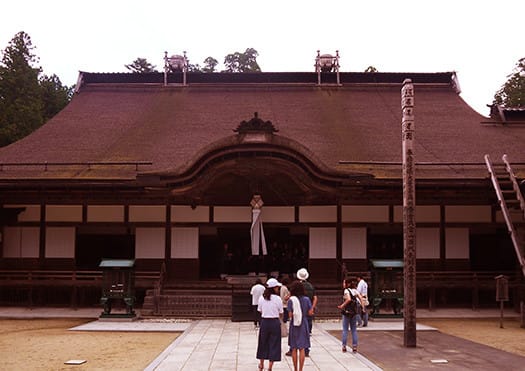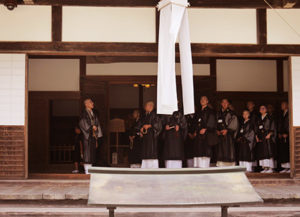



さて昨日は高野槙の写真で記事がややトピズレ方向に行ったので反省。
日本住文化に強い影響を及ぼす建築文化を宗教建築に探る本来趣旨に復帰。
正門をくぐり抜けた先に「主殿」が建つ。2枚目の写真が正規の玄関。
ちょうど、僧侶のみなさんが学ばれている状況に遭遇した。
白い布が天井から下げられていてその説明中のようでしたが、聞き取れなかった。

一方、やや遠景で主殿の屋根上を見ると何かがある・・・「桶」でした。
っていうか樽が据え付けられていて、雨水を溜めているように見える。
調べてみるとこれは天水桶といって、普段から雨水を溜めておいて、
こういう寺院建築では歴史的になんども繰り返された火災が発生した時に、
屋根が燃えないように桶の水をまいて、延焼を食い止める役目を果たすのだとか。
日本の建築は基本的に木造で建てられ続けてきたけれど、
いちばんの弱点は「防火」性能の問題であります。
江戸のような大都会もなんども大火に見舞われ続けた歴史が刻まれている。
日本の住宅法規でももっとも起源的なものは防火に関するモノで、
より燃えやすく延焼の危険性が高い茅葺きは都市住宅では禁忌されてきた。
高価な瓦葺きが行政サイドから推奨され長屋建築などでも普遍化した。
金剛峯寺のような大伽藍寺院でも、また最古の寺院飛鳥寺でも
屋根は瓦葺きが採用されてきている。
まことに重量物であり、高価であったことは間違いないけれど、
この800年代の伽藍建築でも採用されていたことは疑いない。
しかしそれでもなお、灯明・護摩法要など宗教的に火を扱うことは多い。
ミスから引火することも多かったに違いない。
この天水桶を屋根上に装置させることにしたものでしょう。
写真には屋根に早く上るためにハシゴが常置されているし、
屋根の桶の横には鎖も下げられているので、
万が一の場合、それらを使って迅速な防火作業体制が組まれていたことがわかる。
法隆寺も創建直後に出火して建て替えられた痕跡が指摘されていますが、
逆に言うとそれ以降、1500年以上大火災を逃れてきている。
木造建築と防火意識の徹底ということって、
どうも日本人のDNAの深いところに根付いている意識なのかも知れません。
建築が燃えやすい木造であるから、共助の思想の基幹として
みんなが防火という共通目的を強く持ち続けることができた。
今日社会に至ってマスクを自発的にマナーとして守り続ける精神文化って
こういう長い時間の経験知に揺籃されてきたようにも思われますね。
English version⬇
[Fire protection on the roof "Rainwater tank" Shingon Buddhism, Kongobuji Temple-4]
By the way, yesterday, I regret that the article was a little off the top with a photo of Kohya Maki.
Returned to the original purpose of exploring religious architecture, which has a strong influence on Japanese living culture.
After passing through the main gate, the "main hall" is built and the second photo is the regular entrance.
I just encountered a situation where the monks were learning.
A white cloth was hung from the ceiling and it seemed to be being explained, but I couldn't hear it.
On the other hand, when I looked at the roof of the main shrine in a slightly distant view, there was something ... It was a "tub".
I mean, the barrels are installed and it looks like they are collecting rainwater.
When I looked it up, it was called a rainwater tank, and I usually stored rainwater in it.
In this kind of temple construction, when a fire that has been repeated many times historically has occurred
It is said that it plays the role of stopping the spread of fire by watering the tub so that the roof does not burn.
Japanese architecture has basically been built of wood,
The weakest point is the problem of "fire protection" performance.
The history of a big city like Edo, which has been hit by big fires, is engraved.
The most basic thing in Japanese housing regulations is fire prevention.
Thatched roofs, which are more flammable and have a higher risk of fire spread, have been contraindicated in urban housing.
Expensive roofing was recommended by the government and became universal in Nagaya construction.
At a large temple like Kongobuji, or at Asuka-dera, the oldest temple
Tiled roofs have been adopted.
It was really heavy and expensive, but
There is no doubt that it was also used in the cathedral architecture of the 800s.
However, even so, they often deal with fire religiously, such as the votive candles and the Homa memorial service.
It must have often ignited from mistakes.
As a result of devising to keep such ignition to small things
You probably decided to have these devices on the roof.
In the photo, a ladder is permanently placed on the roof so that it can climb quickly.
There is also a chain hanging next to the roof tub, so
In the unlikely event, it can be seen that a quick fire prevention work system was established using them.
It has been pointed out that Horyuji Temple was also rebuilt due to a fire immediately after its construction.
Conversely, since then, it has escaped a major fire for more than 1500 years.
Thorough wooden construction and fire prevention awareness
It may be the consciousness that is deeply rooted in the DNA of the Japanese people.
Since the architecture is a flammable wooden structure, it is the basis of the idea of mutual assistance.
Everyone was able to maintain a strong common purpose of fire protection.
The spiritual culture that reaches society today and continues to voluntarily protect masks as manners
It seems that it is based on this kind of experience.



















